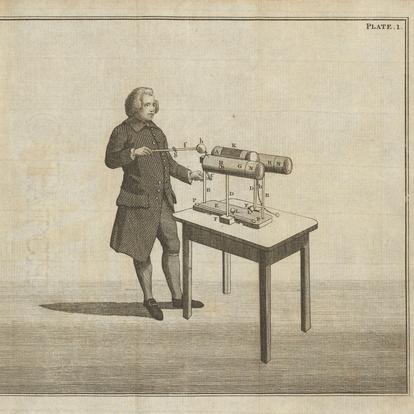THE COLLECTION
WHAT IS A CABINET?
Back in the Renaissance princes and Royals collected precious stones and other objects with presumed magical properties. This developed into collections of curiosities and art collections. Later, the bourgeoisie also began to form collections.
During the Enlightenment, such collections were systematized and divided into specialized collections. Natural history collections were used to increase knowledge about the natural world. We also saw the rise of collections of scientific instruments such as Hauchs'.
These scientific instruments and apparatus were used to entertain, to illustrate scientific processes or ideas, and to perform measurement and to do research.
Scientific instrument collections were very expensive and much prestige was attracted to having one. England's King Georg III had one. There were smaller collections in Copenhagen. Hauch Collection was one of the best.
The instruments and other objects were often stored in cabinets, hence the word 'cabinet' for a collection.
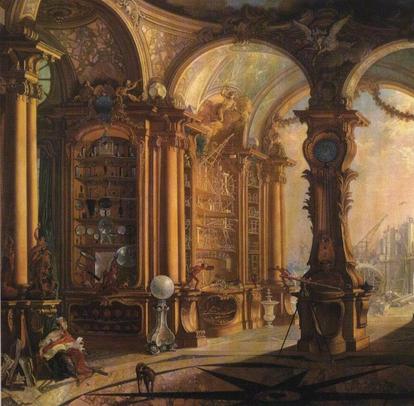
HAUCH'S PHYSICS CABINET
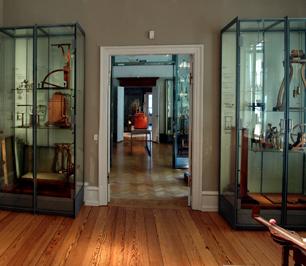
Hauchs Physiske Cabinet, i.e. physics collection, was created by A.W. Hauch during the years 1790-1827. The collection shows Hauch strong passion for science and represents an enormous investment. Due to the comprehensive nature of the collection, it gives us a clear image of what went on in physics and chemistry around 1800.
Indeed, Hauch purchased almost all the types of scientific instruments, apparatuses and toys that existed during his lifetime. And it was an exciting time. Modern science as we know it was in its infancy. There were many unresolved questions. For instance, what is electricity? Why are some kinds of air good for people and other types not? How do we measure the physical world? etc.
THE SCIENTIFIC JOURNEY
Inspired by P.C. Abildgaard, Hauch became interested in science. He had between 1788-1800 learned all he could about physics and chemistry in Copenhagen through self-study and by following public lectures. He realized that it required apparatus’ and international knowledge if he were to further his interest. He wanted a Physical Cabinet – A collection of scientific instruments.
I 1788 he went on the journey of his life. The journey went through Germany, Holland, England and France. He came into contact with the leading scientists of the time as Klaproth, Bode, van Marum, Banks, Cavendish, Charles, Priestly, Herschel and Lavoisier. He purchased instruments from leading Instrument companies Catel, Adams, Nairne, Ramsden and Dumoitiers. He wanted to go to Italy but was called home by the King to be Master of the horse.
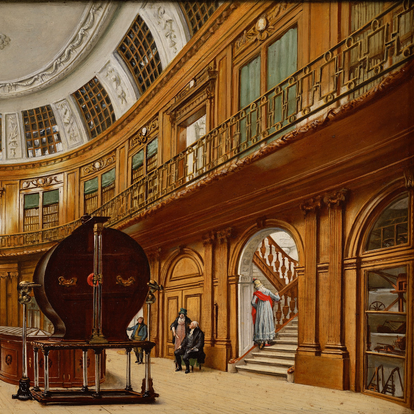
HE LECTURED, RESEARCHED AND WROTE
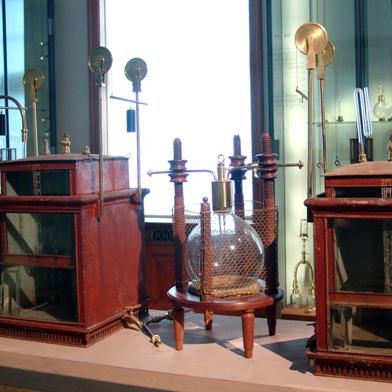
The journey had ended. Hauch was back on the career ladder in the royal household. But that didn't mean that he put his scientific interests on standby. On the contrary, the cabinet and his scientific activities came to a full bloom. Hauch began to lecture, do research and to write.
Contemporaries described him as an accomplished lecturer. He published a textbook on physics and chemistry which was translated into Swedish and German, and also published a description of his cabinet, “Det Physiske Cabinet”. Hauch also published articles in the Proceedings of the Danish Royal Society of Sciences and Letters. He became a member in 1791 and later it’s president.
Hauch did not make ground-breaking discoveries. He improved and developed experiments to test important scientific questions in his time. His thoroughness that was highly respected both in Denmark and abroad. Hauch was offered a professorship of physics at the University of Göttingen, but politely declined and received an honorary doctorate from the University of Copenhagen in 1821.
DAYS IN THE CABINET
Prince Christian Frederik, the later Christian VIII of Denmark paid a visit to the cabinet on Thursday, March 17th 1803. He wrote the following in his diary:
‘In the morning I was in the cabinet of chamberlain Hauch, where the prince of Gloucester performed experiments with oxygen, hydrogen and chlorine gas. The latter made the prince have a very strong and unpleasant cough’.
The Prefect of Plön, August Hennings, visited the cabinet in 1802 and wrote:
‘Yesterday morning flew away at Lord Chamberlain Hauch’s place, who not only showed us his supply of physics instruments but also performed various electrical and other experiments. As you know, he does not own his collection as an expression of distinction or as a lover of precious and rare things. He has it because he is a true scholar and has used them for lectures. It is therefore not unusual for him to show the instruments in this way, to explains their purpose and set up experiments. He has invented or improved some of these and described them in the Proceedings of the Royal Danish Society. To scholars, he is known for his writings.’
Hauch gave lectures in the cabinet for the upper echelons of the Royal Household, the bourgeois, military people, students and scholars. For instance, the Danish Prime Minister’s wife, Charlotte Frederikke Reventlow, in a letter to a friend, dated December 20th 1793 wrote: ‘
It's uncomfortable that Hauch lectures just fall upon the two postal days. For this reason, I can only write a short letter because I have to begin my toilette. It is by the way very interesting to listen to him; He presents everything in a very understandable way; I can follow him very well, only not always when it comes to the calculations.’
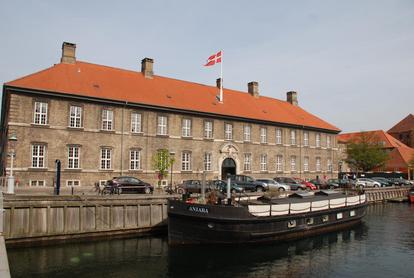
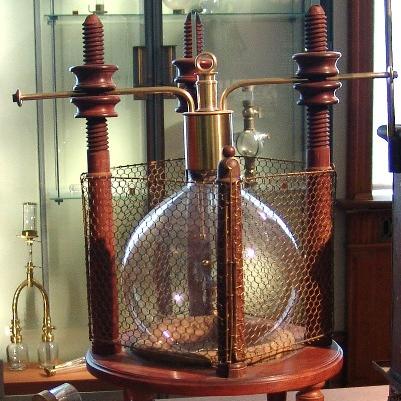
HAUCH'S INSTRUMENTS AND PUBLICATIONS
I the cabinet we see a number of instruments that had been invented earlier, but which Hauch improved upon:
- A gasometer, to show that water is not an element
- A eudiometer, for measuring the goodness of the air
- An electrometer for measuring electric discharges
He described them in the Proceedings of the Royal Danish Society:
- Experiments for an improved discharge electrometer (1791)
- Examination of the components of the water (1792)
- Description of a new air sampler or Eudiometer (1792)
- Description of an improved gasometer or air measurer and experiments performed with this (1793)
Articles also included:
- Description of the so-called burning Harmonica, or the strange and strong sound in certain circumstances produced by the combustion of hydrogen (1798)
- An attempt at producing a more correct theory than the one hitherto used in explaining the use of the horse bit (1798)
- Description of some experiments performed with Phosphor (1789)
- On Thunder, which in the winter in various locations in Norway and in several Nordic regions are nearly as frequent as in the summer (1800)
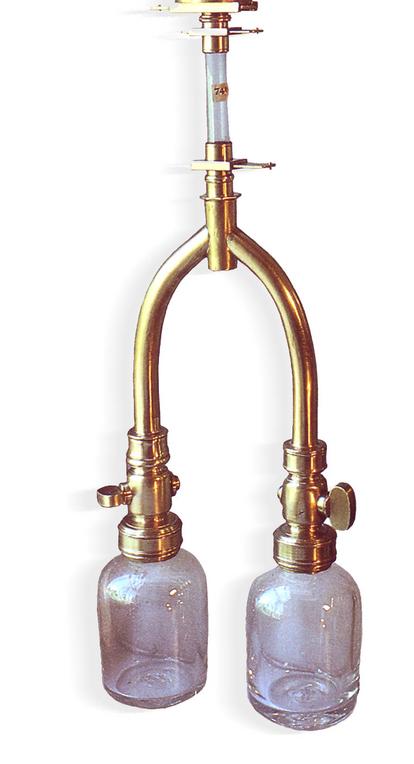
TO SORØ ACADEMY
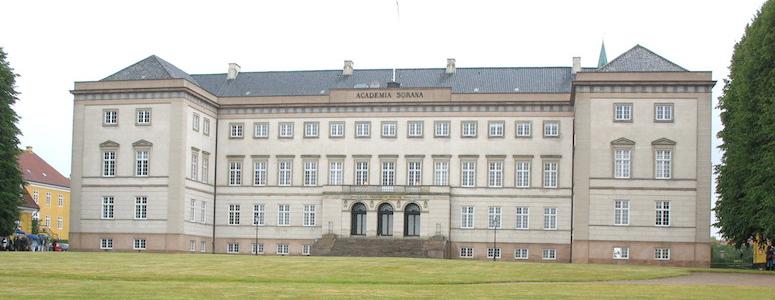
The Purchase of all the instruments weighed heavily on Hauch's private economy. So did the acquisition of Antvorskov Manor House in 1806, which he had to sell again in 1810 with considerable losses. The State bankruptcy of the Danish state in 1813 worsened the situation and one of Hauch's loans had to be met in 1815. It looked hopeless.
But Hauch close relation to King Frederik VI of Denmark saved him. The King bought the collection in 1815. In connection with the inauguration of Sorø Academy's new main building in 1827Ænkede, the King bestowed the collection to the Academy. AEt first, the collection was housed in the impressive stately room in the main building. But the instruments soon became obsolete. They were moved to the attic and staid there until rediscovered as museum pieces. The collection is today seen as one of the best collections of its kind in Europe.
